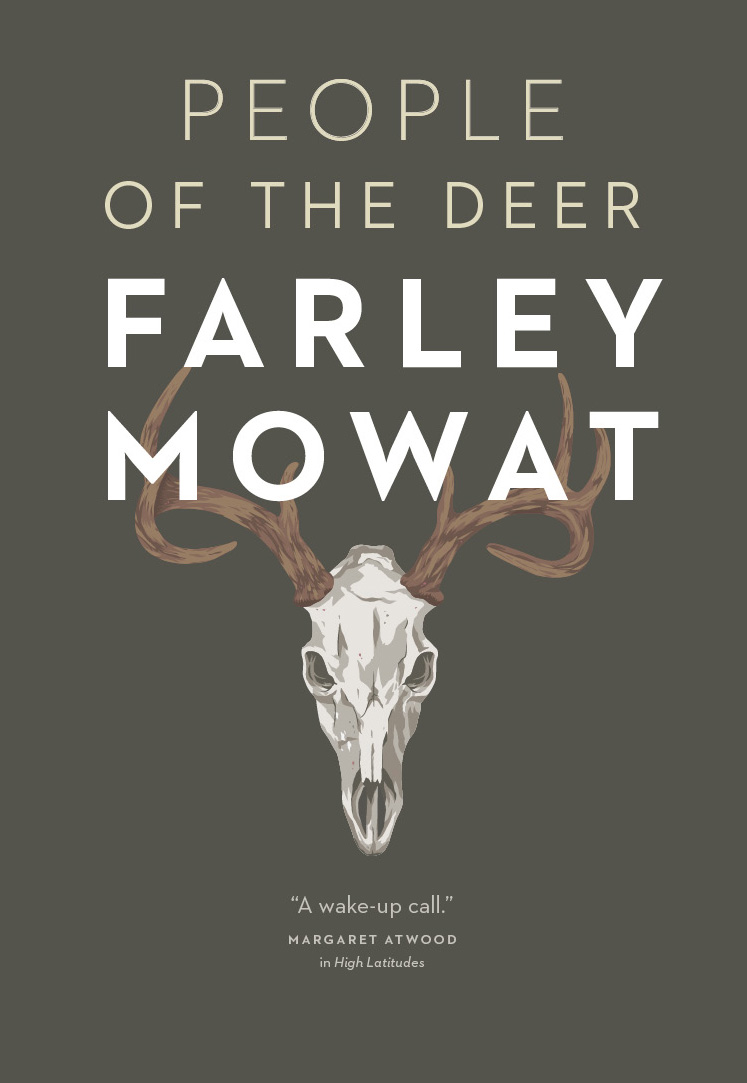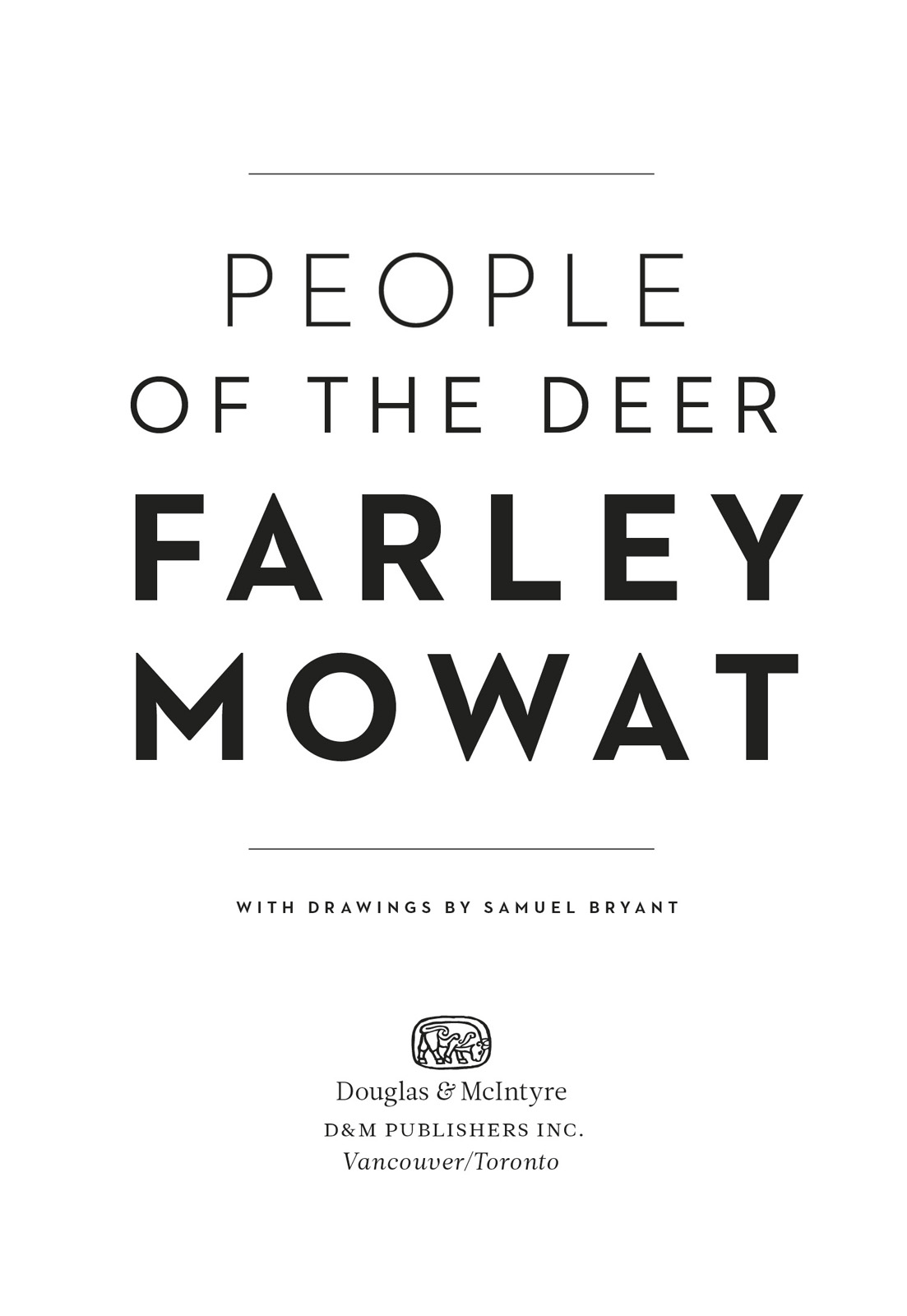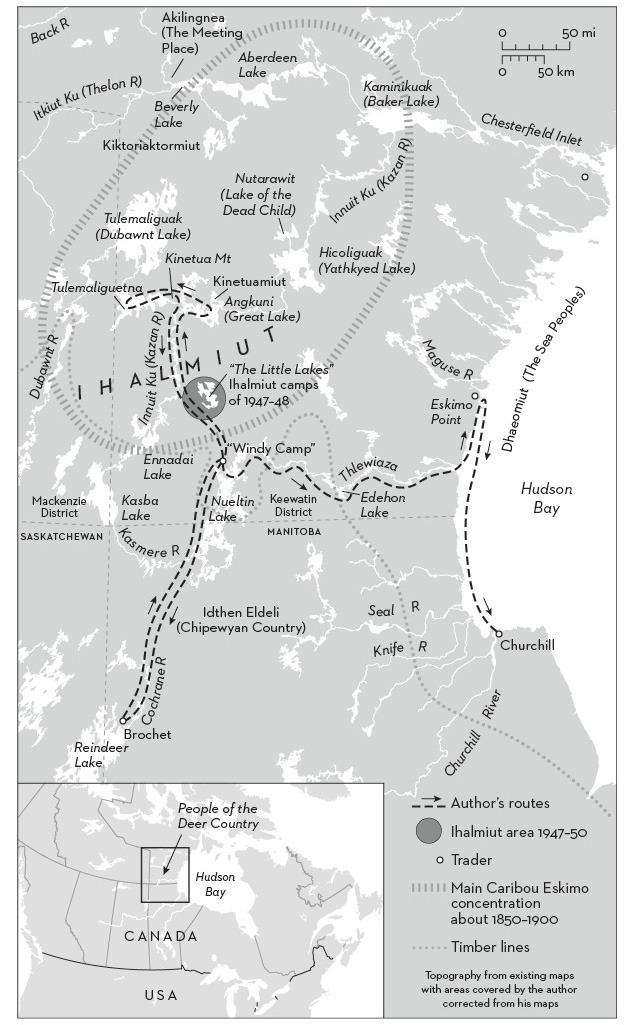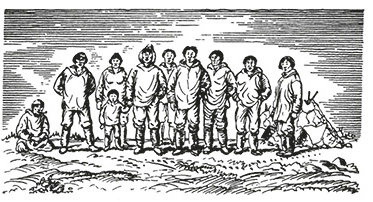People of the Deer



To Frances,
Ohoto's friend
“I am still tied to the Barrens, not by the simple web of memories alone, but by something more powerful. There is an abiding affection in my heart for the men and women of the plains who lent me their eyes so that I was privileged to look backward through the dark void of years and to see not only the relics of forgotten times, but also to see into the minds and the thoughts of the men of those times. It was a great gift I had from the People and one that deserved repayment...”

On an evening when the sun hovered above the horizon's lip, I sat beside a man who was not of my race, and watched a spectacle so overwhelming in its magnitude that I had no words for it.
Below us, on the undulating darkness of the barren plains, a tide of life flowed out of the dim south and engulfed the world, submerged it so that it sank beneath a living sea. The very air was heavy with the breath of life itself. There was a sound of breathing and of moving that was like a rising wind. It was as if the inanimate and brutal crust of rock had been imbued with the essential spark and had risen from its ageless rigidity to claim the rights of life.
The man who sat beside me stared over the rolling hordes that swept in upon us, and it was as if he stretched the hands of his soul out to the floodâthe eddying, turbulent and all-embracing flood.
I felt afraid. The man beside me was no longer there. In some way that I could not fathom he had gone from me and had flung himself into that living torrent. There was an ecstasy upon him then. The man was gone, his spirit had sought and found a union with the amorphous, living entity which had possessed his land.
I could not understand, for I was a stranger in that place, but the man who had been beside me was of the land. He was more than that. He was of this profound, incredible thing I was beholding.
Darkness was full upon us before the man returned to me. There was no light left upon the plains, but the unseen shadows still held the faint murmur of ten thousand vital hearts beating with strength and power on every side of us. It was too dark to see and yet I knew the man had turned his face toward me, fixed his eyes on mine. He spoke so quietly it might have been that I heard words spoken from the divided voice of the monstrous visitation I had witnessed.
“
Tuktu-mie
... ” The words came slowly... “This is the Hostâthe Legion of the Deer...”
At the time
People of the Deer
was published, in 1952, it was impossible for me to obtain documentary corroboration for much of the story. The book dealt harshly with the Old Empires of the Northâthe missions, the RCMP, the trading companies and the federal governmentâwho between them possessed all of the official “evidence.” They were not about to give me access to the documentary proof of their errors of omission and commission. I was therefore forced to be somewhat circumspect. Some of the names used had to be pseudonyms. Furthermore, I was sometimes forced to refrain from correctly identifying events in terms of time and locale.
By 1959, when I wrote
The Desperate People,
conditions had altered drastically and I was able to obtain the requisite documentationâthe paper “proof' of the truth. Consequently, in
The Desperate People
all names used were the correct ones and the events were presented in their actual spatial and temporal contexts. Where apparent discrepancies occur between the two books, the version given in
The Desperate People
is the correct one.
In the Preface to
The Desperate People
âmy 1959 sequel to
People of the Deer
âI wrote: “There are now belated signs of a lightening on the somber horizon of the Canadian arctic; but this may be no more than the illusion of a false sunrise in a polar winter...”
It is now fifteen years since those words were written and the sunrise has proved to be an illusion in all truth. The physical disruptions which our society inflicted on the Eskimos during the first half of this century have been ameliorated to the extent that few Eskimos now die of physical neglect. Since about 1960 we have made considerable efforts to ensure that they will survive in the flesh; but at the same time we have pursued a policy which is very efficiently destroying them psychically. We have made a ruthless and concerted effort to dispossess them from their own age-old way of life and thought and to force them into the mold of our modern technological society. Assimilation has been our goal... and it has failed disastrously. In 1974 almost all Canadian Eskimos have been broken away from the support of their land (which is theirs no longer) and live clustered in modern slumsâmany of them hardly better than ghettosâin not many more than a score of artificial settlements along the rim of the Canadian North. Here they exist for the most part on welfare payments of one kind or anotherâno longer taking sustenance from the land and the sea. Effectively they live in unguarded concentration camps, provided with the basic requirements for mere physical survival, but deprived of the freedom to shape and control their own lives. We have salved our national conscience by ensuring that they do not die anymore of outright starvation, but we have resolutely denied them the right to live according to their own inherent needsâthe right to function as viable human beings according to their own desires and capabilities.
Genocide can be practiced in a variety of ways.
The Desperate People, of whom I wrote in 1952 and 1959, are desperate still. But
now
they include all the native peoples of CanadaâIndian, Eskimo and mixed bloods. They are making what may be their last convulsive effort to achieve survival apart from, and despite, a society which will accept them only if they transform themselves into second-class simulacrums of Western man. They are fighting what may well be their ultimate battle to exist in the world according to their own concept of what their lives should be. They are making what is probably their final effort to achieve the freedom to be themselves.
We have long prided ourselves on being a democratic nation, dedicated to the altar of freedom. Freedom for whom? If it is only freedom for ourselves to do as we please at the expense of others, then our pious stance is even more abhorrent than that of any overt tyrantâfor ours is based upon a vile hypocrisy.
To have freedom one must give freedom. Let us put our vaunted belief in freedom to the test. Let us give back the freedom that we have taken from the native peoples of this land. If we cannot do this, then not only are they doomed, but we will have doomed ourselves as well.
Because the time is short, and the time is now, and that time will not come again, I am reissuing this book in the hope that it may help us to understand and to acknowledge the crimes against humanity we have perpetrated here,
in our country,
under the aegis of a free democracy... crimes which we are perpetrating still in a more subtle guise.
F.M.
March 1974
Port Hope, Ontario
 The Why and Wherefore
The Why and WhereforeIn the spring of 1935, when I was an undersized youth of fourteen, I made my first journey into arctic lands, under the tutelage of a great-uncle who was an amateur but fanatical student of birds. My Uncle Frank's consuming interest in wild things had been perpetuated in me, for from the age of six I too had been passionately interested in all the animals that haunted the rolling prairies near my home in Saskatoon. Our house in that western city had for long years been shared with pet skunks, coyotes, crows, gophers and rattlesnakes of uncertain disposition. Even my human friends were chosen almost exclusively from the half-wild and suitably ragged children at the Dundurn Indian Reserve, for I shared with those sons of nomads a strange devotion to the illusory freedom of the broad prairie plains. That restless longing to find affinity with primordial things was a legacy from my father, but it took shape and gained direction under the influence of Great-uncle Frank. He, at my mother's request, undertook to take me with him on one of his yearly pilgrimages to the ancient tundras of the arctic, where we were to spend a summer among the curious Northern birds whose very names were mystery in my ears, and whose ways of life were old before ours were begun.
In the first week of May 1935, the meadowlarks brought spring to Saskatoonâand Uncle Frank was close behind. Tall, gaunt and weather-worn, he was still filled with the indestructible energy which had carried him through arduous years of struggle with the tough sod of an Alberta wheat farm. He had acquitted himself well in that long battle against hail and blight, and now in his late sixties he was able to indulge his lifelong hobby, and so each new spring saw him voyaging to some distant place to watch birds whose lives he longed to know and understand.
To my young eyes, Uncle Frank was a somewhat dusty Olympian and beside him I felt as insignificant as a blade of twitch grass. Yet when he looked down upon me from his great, spare height, he seemed to be vaguely satisfied with what he saw and so, on the day following his arrival at Saskatoon, we two set off together for Winnipeg, the central gateway to the arctic lands. It was the beginning of an odyssey.
From Winnipeg the railroad sweeps westward in a wild curve over the flat, rich wheatlands which are the bed of ancient Lake Agassiz, a mighty lake that died with the last glacier. Then the steel bends northward and the train passes through the flat farmlands, and little villages go byâeach marked by the bulge of an orthodox steeple and the square monument of a grain elevator. Slowly the forests extend their rough fingers into the black soil of the farms, until the fingers close tightly. The prairies are gone, and only the matted disorder of forests remains.
The train runs more cautiously now, for it is entering a land that is hostile to strangers. It makes its way northward through the low forests which are the home of the Cree Indians, and at last it draws up with gusty relief at the frontier town of The Pas. Here, in a decaying cluster of buildings, the Winnipeg train turns gratefully back to the south and hurries to leave behind it the anonymous tangle of forests and muskegs.
But The Pas, that seedy settlement which has been left behind to wither and rot as the frontier has pushed north, is not yet the end of the steel. Instead, it is the southern terminus for a cockeyed political shenanigan that is proudly known in Canada's capital as “the Hudson Bay Railway” but is better known in the land where it lives as “the Muskeg Express.” A rebellious and contrary railway that may have an equal in the wilds of Siberia, the Muskeg Express has no relatives on this continent. It stretches northward for five hundred desolate miles to the shore of Hudson Bay. It thinks nothing of running a hundred miles at a time without curves and without bends to relieve the heavy-footed pace it maintains.
For part of the way its roadbed is built on blocks of ancient peat moss, and this moss in turn sits uneasily on the perpetual ice of the muskegs and swamps, whose black depths hold the last dominions of the old, vanished glaciers.
The only passenger accommodation on the train was in the caboose. So Uncle Frank and I lived there for the three days and two nights that the journey consumed. I amused myself by keeping track of the little white-painted signboards which marked off each mile and by counting the number of rail spikes per mile that flew out of the ties and went buzzing off through the air like bullets, as the train passed along. I was grateful to the mile-boards, and to the spikes, for the monotony of that northward journey through the unchanging and somber forests was almost unbroken by anything else.
But at Mile 410 something
did
happen, something that was to lead me into an undreamed-of world in the years which still lay far ahead. Near Mile 400, I had noticed that the maddening succession of stunted and half-drowned spruce trees was beginning to be pierced by long, finger-like openings running down from the northwest. When I pointed them out to my Uncle Frank, he explained that these were the slim tentacles which were being thrust southward by those great arctic plains we call the Barrens, and the presence of these fingers of the plains marked the passing of the dominion of forests.
I climbed up to the high bench of the caboose cupola to have a better look at the new lands which were appearing, and I was there when the marker for Mile 410 came into view, and simultaneously the rusty whistle of the old engine began to give tongue. It was to continue sounding for a full half-hour, with a reckless disregard for steam pressure. But at the first blast I looked forward over the humped backs of the freight carsâand noticed the whistle no more!
A brown, flowing river had appeared and was surging out of the edge of the dying forests and plunging across and over the snow-covered roadbed ahead. A broad, turbulent ribbon of brown ran out of an opening to the southeast and traced its sinuous course northwest over the snows of a land that was still completely gripped by the frostsâfor this was no river of water, but a river of life. I had my binoculars to my eyes in the instant, and through the lenses I saw the stream dissolve into its myriad parts and each part of that river was the long-legged shape of a deer!
“C'est la Foule!”
The French-Canadian brakeman stood beside me, and at the sound of his words I understood what it was that I was beholding. “It is the Throng!” Those were the words that the first of the early French explorers wrote in his journal when he beheld what is perhaps the most tremendous living spectacle that our continent knowsâthe almost incredible mass migration of the numberless herds of caribouâthe reindeer of the Canadian North.
The train whistle continued to blow with increasing fury and exasperation but the rolling hordes of the caribou did not deviate from their own right of way, which took precedence over man's. They did not hurry their steady lope and, as we drew up to them, the engine gave up its futile efforts to intimidate the Throng, and with a resigned whiffle of steam we came to a halt. It was a long halt. For the next hour we stayed there, and for an hour the half-mile-wide river of caribou flowed unhurriedly north in a phenomenal procession, so overwhelming in its magnitude that I could hardly credit my senses. Then, abruptly, the river thinned out and in a few moments was gone, leaving behind it a broad highway beaten into the snow. The old train gathered its waning strength; the passengers who had alighted to brew up some tea climbed aboard, and we too continued into the north.
The stunted trees closed in again and the white mile-boards flickered past as if the sight of the Throng had been only an illusion in time and in space. But it was no illusion, for every detail of that sight remains with me now, with a clarity that does not belong to illusions. It was a sight that a boyâor a manâdoes not forget. And the sight I beheld at Mile 410 was, many years later, to draw me inexorably back to the land of
la Foule.
In its own good time, the Muskeg Express brought us out of the forests and within sight of the ice-filled waters of Hudson Bay, and to the end of a journey. I spent that summer at Churchill in a fly-haunted search for birds' eggs, under the untiring direction of my uncle. The spectacle of
la Foule
faded to the back of my mind, for on the sodden muskegs there were too many strange birds callingâthe Hudsonian curlews with their haunting whistles; the godwits, and the snow buntings and longspurs. There was too much for me to see, there on the south verges of the arctic, and too much to hear.
With the last summer days of 1935 I again climbed back aboard the Muskeg Special and left the tantalizing borders of the Barrens behind me for a decade. I returned home with a large box of birds' eggs, a tin can containing six live lemming-mice, and a crate holding a queer bird called a jaeger (a hunter), which looks like a gull and acts like a hawk.
In addition to these things I brought back many memories, both varied and vivid. Yet, as time passed, it was the memory of the great herd of caribou at Mile 410 that emerged as the strongest of all. And that particular memory was kept alive, and grew more powerful as I grew older, because of an intangible longing that the arctic had implanted so deeply in my heart that its fever could not be chilled even by the passing years.
It is, I suppose, a sort of diseaseâan arctic feverâand yet no microscope can discover its virus and it remains completely unknown to the savants of science. The arctic fever has no effect on the body but lives only in the mind, filling its victim with a consuming urge to wander again, and forever, through those mighty spaces where the caribou herds flow like living rivers over the roll of the tundra. It is a disease of the imagination, and yet it attacks men whom you would not normally accuse of being imaginative. It is this unknown disease that drives taciturn white men back to their crude log shanties year after year, back to the desperate life of the interminable winter night, and back to the wind and the search through the gray snow for the white fox and ermine. The disease is one of great power indeed; for it does not leave such victims as these until life itself leaves them.
The infection lay dormant in me for many years. From 1935 until 1939 my life held so many things that the call of the bleak lands to the north was never strong enough to take command of my will. During those years I went on with my schooling, spending my holidays on the prairies, in the mountains to the west and in the forests to the eastâbut never completely forgetting the stark plains to the north. In those years I was particularly engrossed in the study of birds and mammals, for I had decided that I would become a zoologist and spend my life at that study.
But then, when I was nineteen years old, I had to exchange my old shotgun for a Lee-Enfield rifle, for I became a soldier in the Hastings and Prince Edward Regiment. I exchanged the prairies and mountains for the close confines of an infantry regiment, and the world that now lay outside those narrow bounds suddenly became a mad, nightmare creation which I feared and could not understand. Then 1941 came, and I was part of the phony war in southern England and on my brief leaves I watched without comprehension as the walls of great cities crumbled over the dismembered bodies of men. I began to know a sick and corroding fear that grew from an unreasoned revolt against mankindâthe one living thing that could deliberately bring down a world in senseless slaughter. The war drove inexorably on. My regiment moved through Italy, then up through France into Belgium and Holland, and at long last into the Reich. And one day there were no more crashes of shellfire in the airâand it was done.
In the spring of 1946 I returned to my own landâbut it was a far cry from my return to my home in 1935. I wished to escape into the quiet sanctuaries where the echoes of war had never been heard. And to this end, I at once arranged to become what is called a “scientific collector” who would go into far places and bring back rare specimens for science to stare at. Desperately seeking for some stable thing rooted deep in reality, I grasped the opportunity to labor in what I thought was the austere pursuit of knowledge for its own sake.
So it was that at the end of 1946 I found myself far up in the forests of northern Saskatchewan at a place called Lac La Ronge. Nominally I was there to collect birds for a museum, but I had put my gun away, for I soon had enough of “scientific” destruction, even as I had had enough of killing in wartime. The search for tranquillity which had led me hopefully into science had failed, for now I could see only a brutal futility in the senseless amassing of little bird mummies which were to be preserved from the ravages of life in dark rows of steel cabinets behind stone walls. So I was simply living, without any particular aim, in a remote settlement of Cree Indian half-breeds; and there, among a people who had been brutalized and who had been degraded and led to decay by all that is evil in civilized lifeâthere I found a man who unwittingly gave me a direction and a new goal.
From old Henry Moberly, a half-breed who had spent most of his years on the borders of the northernmost forests, I once again heard of the caribou that I had seen so many years before. Henry told me living tales of the “deer”âas the caribou are universally called in the landâso that I remembered
la Foule
with startling clarity; and it was then that the quiescent disease of the arctic sprang to new life within me, and began to possess me completely.
